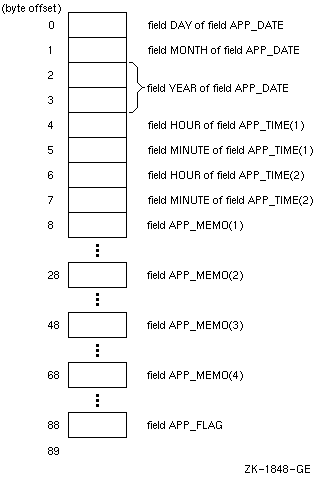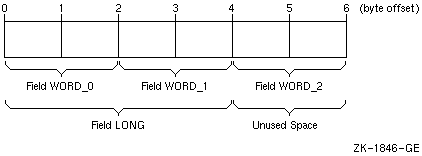Software > OpenVMS Systems > Documentation > 82final > 6324 HP OpenVMS Systems Documentation |
HP Fortran for OpenVMS
|
| Previous | Contents | Index |
The VIRTUAL statement is included for compatibility with PDP-11 Fortran. It has the same form and effect as the DIMENSION statement (see Section 5.6).
In HP Fortran, you can use an alternative syntax for octal and hexadecimal constants. The following table shows this alternative syntax and equivalents:
| Constant | Alternative Syntax | Equivalent |
|---|---|---|
| Octal | ' 0..7 ' O | O ' 0..7 ' |
| Hexadecimal | ' 0..F ' X | Z ' 0..F ' |
You can use a quotation mark (") in place of an apostrophe in all the above syntax forms.
In HP Fortran, you can specify the following form for a record specifier in an I/O control list:
|
r
Is a numeric expression with a value that represents the position of the record to be accessed using direct access I/O.The value must be greater than or equal to 1, and less than or equal to the maximum number of records allowed in the file. If necessary, a record number is converted to integer data type before being used.
If this nonkeyword form is used in an I/O control list, it must immediately follow the nonkeyword form of the io-unit specifier.
In HP Fortran, you can specify the following form of the DELETE statement when deleting records from a relative file:
|
io-unit
Is the number of the logical unit containing the record to be deleted.r
Is the positional number of the record to be deleted.label
Is the label of an executable statement that receives control if an error condition occurs.i-var
Is a scalar integer variable that is defined as a positive integer if an error occurs and zero if no error occurs.
This form deletes the direct access record specified by r.
On the DELETE statement, see Section 12.3.
In HP Fortran, you can use the following form for an external record:
|
group-name
Is the name of the group containing the objects to be given values. The name must have been previously defined in a NAMELIST statement in the scoping unit.object
Is the name (or subobject designator) of an entity defined in the NAMELIST declaration of the group name. The object name must not contain embedded blanks, but it can be preceded or followed by blanks.value
Is a null value, a constant (or list of constants), a repetition of constants in the form r*c, or a repetition of null values in the form r*.
If more than one object=value or more than one value is specified, they must be separated by value separators.
A value separator is any number of blanks, or a comma or slash, preceded or followed by any number of blanks.
On namelist input, see Section 10.3.1.3; output, see Section 10.5.1.3.
The POINTER statement discussed here is different from the one discussed in Section 5.15. It establishes pairs of variables and pointers, in which each pointer contains the address of its paired variable.
This POINTER statement takes the following form:
|
pointer
Is a variable whose value is used as the address of the pointee.pointee
Is a variable; it can be an array name or array specification.
The following are pointer rules and behavior:
| ALLOCATABLE | INTRINSIC | POINTER |
| EXTERNAL | PARAMETER | TARGET |
Using %LOC: Using MALLOC: Using LIB$GET_VM:
INTEGER I(10) INTEGER I(10) INTEGER I(10)
INTEGER I1(10) /10*10/ POINTER (P,I) INTEGER LIB$GET_VM,STATUS
POINTER (P,I) P = MALLOC(40) POINTER (P,I)
P = %LOC(I1) I(2) = I(2) + 1 STATUS = LIB$GET_VM(P,40)
I(2) = I(2) + 1 IF (.NOT. STATUS) CALL EXIT(STATUS)
I(2) = I(2) + 1
|
The following are pointee rules and behavior:
| ALLOCATABLE | OPTIONAL | SAVE |
| AUTOMATIC | PARAMETER | STATIC |
| INTENT | POINTER | TARGET |
HP Fortran record structures are similar to Fortran 95/90 derived types.
A record structure is an aggregate entity containing one or more elements. (Record elements are also called fields or components.) You can use records when you need to declare and operate on multi-field data structures in your programs.
Creating a record is a two-step process:
On derived types, see Section 3.3.
A structure declaration defines the field names, types of data within fields, and order and alignment of fields within a record. Fields and structures can be initialized, but records cannot be initialized.
A structure declaration takes the following form:
|
structure-name
Is the name used to identify a structure, enclosed by slashes.Subsequent RECORD statements use the structure name to refer to the structure. A structure name must be unique among structure names, but structures can share names with variables (scalar or array), record fields, PARAMETER constants, and common blocks.
Structure declarations can be nested (contain one or more other structure declarations). A structure name is required for the structured declaration at the outermost level of nesting, and is optional for the other declarations nested in it. However, if you wish to reference a nested structure in a RECORD statement in your program, it must have a name.
Structure, field, and record names are all local to the defining program unit. When records are passed as arguments, the fields in the defining structures within the calling and called subprograms must match in type, order, and dimension.
field-namelist
Is a list of fields having the structure of the associated structure declaration. A field namelist is allowed only in nested structure declarations.field-declaration
Also called the declaration body. A field-declaration consists of any combination of the following:
- Type declarations ( Section B.12.1.1)
These are ordinary Fortran data type declarations.- Substructure declarations ( Section B.12.1.2)
A field within a structure can be a substructure composed of atomic fields, other substructures, or a combination of both.- Union declarations ( Section B.12.1.3)
A union declaration is composed of one or more mapped field declarations.- PARAMETER statements
PARAMETER statements can appear in a structure declaration, but cannot be given a data type within the declaration block.
Type declarations for PARAMETER names must precede the PARAMETER statement and be outside of a STRUCTURE declaration, as follows:
INTEGER*4 P STRUCTURE /ABC/ PARAMETER (P=4) REAL*4 F END STRUCTURE REAL*4 A(P)
Unlike type declaration statements, structure declarations do not create variables. Structured variables (records) are created when you use a RECORD statement containing the name of a previously declared structure. The RECORD statement can be considered as a kind of type declaration statement. The difference is that aggregate items, not single items, are being defined.
Within a structure declaration, the ordering of both the statements and the field names within the statements is important, because this ordering determines the order of the fields in records.
In a structure declaration, each field offset is the sum of the lengths of the previous fields, so the length of the structure is the sum of the lengths of its fields. The structure is packed; you must explicitly provide any alignment that is needed by including, for example, unnamed fields of the appropriate length.
By default, fields are aligned on natural boundaries; misaligned fields are padded as necessary. To avoid padding of records, you should lay out structures so that all fields are naturally aligned.
To pack fields on arbitrary byte boundaries, you must specify a compiler option. You can also specify alignment for fields by using the cDEC$ OPTIONS or cDEC$ PACK general directive.
A field name must not be the same as any intrinsic or user-defined operator (for example, EQ cannot be used as a field name).
In the following example, the declaration defines a structure named APPOINTMENT. APPOINTMENT contains the structure DATE (field APP_DATE) as a substructure. It also contains a substructure named TIME (field APP_TIME, an array), a CHARACTER*20 array named APP_MEMO, and a LOGICAL*1 field named APP_FLAG.
STRUCTURE /DATE/
INTEGER*1 DAY, MONTH
INTEGER*2 YEAR
END STRUCTURE
STRUCTURE /APPOINTMENT/
RECORD /DATE/ APP_DATE
STRUCTURE /TIME/ APP_TIME (2)
INTEGER*1 HOUR, MINUTE
END STRUCTURE
CHARACTER*20 APP_MEMO (4)
LOGICAL*1 APP_FLAG
END STRUCTURE
|
The length of any instance of structure APPOINTMENT is 89 bytes.
Figure B-1 shows the memory mapping of any record or record array element with the structure APPOINTMENT.
Figure B-1 Memory Map of Structure APPOINTMENT

The syntax of a type declaration within a record structure is identical to that of a normal Fortran type statement.
The following rules and behavior apply to type declarations in record structures:
INTEGER %FILL (2,2) |
INTEGER %FILL /1980/ |
A field within a structure can itself be a structured item composed of other fields, other structures, or both. You can declare a substructure in two ways:
See the example in Section B.12.1 for a sample structure declaration containing both a nested structure declaration (TIME) and an included structure (DATE).
A union declaration is a multistatement declaration defining a data area that can be shared intermittently during program execution by one or more fields or groups of fields. A union declaration must be within a structure declaration.
Each unique field or group of fields is defined by a separate map declaration.
A union declaration takes the following form:
|
map-declaration
Takes the following form:
- MAP
- field-declaration
- [field-declaration]
- ...
- [field-declaration]
- END MAP
field-declaration
Is a structure declaration or RECORD statement contained within a union declaration, a union declaration contained within a union declaration, or the declaration of a data field (having a data type) within a union. See Section B.12.1 for a more detailed description of what can be specified in field declarations.
As with normal Fortran type declarations, data can be initialized in field declaration statements in union declarations. However, if fields within multiple map declarations in a single union are initialized, the data declarations are initialized in the order in which the statements appear. As a result, only the final initialization takes effect and all of the preceding initializations are overwritten.
The size of the shared area established for a union declaration is the size of the largest map defined for that union. The size of a map is the sum of the sizes of the fields declared within it.
Manipulating data by using union declarations is similar to using
EQUIVALENCE statements. The difference is that data entities specified
within EQUIVALENCE statements are concurrently associated with a common
storage location and the data residing there; with union declarations
you can use one discrete storage location to alternately contain a
variety of fields (arrays or variables).
With union declarations, only one map declaration within a union declaration can be associated at any point in time with the storage location that they share. Whenever a field within another map declaration in the same union declaration is referenced in your program, the fields in the prior map declaration become undefined and are succeeded by the fields in the map declaration containing the newly referenced field.
In the following example, the structure WORDS_LONG is defined. This structure contains a union declaration defining two map fields. The first map field consists of three INTEGER*2 variables (WORD_0, WORD_1, and WORD_2), and the second, an INTEGER*4 variable, LONG:
STRUCTURE /WORDS_LONG/
UNION
MAP
INTEGER*2 WORD_0, WORD_1, WORD_2
END MAP
MAP
INTEGER*4 LONG
END MAP
END UNION
END STRUCTURE
|
The length of any record with the structure WORDS_LONG is 6 bytes. Figure B-2 shows the memory mapping of any record with the structure WORDS_LONG:
Figure B-2 Memory Map of Structure WORDS_LONG

A RECORD statement takes the following form:
|
structure-name
Is the name of a previously declared structure.record-namelist
Is a list of one or more variable names, array names, or array specifications, separated by commas. All of the records named in this list have the same structure and are allocated separately in memory.
You can use record names in COMMON and DIMENSION statements, but not in DATA or NAMELIST statements.
Records initially have undefined values unless you have defined their values in structure declarations.
| Previous | Next | Contents | Index |